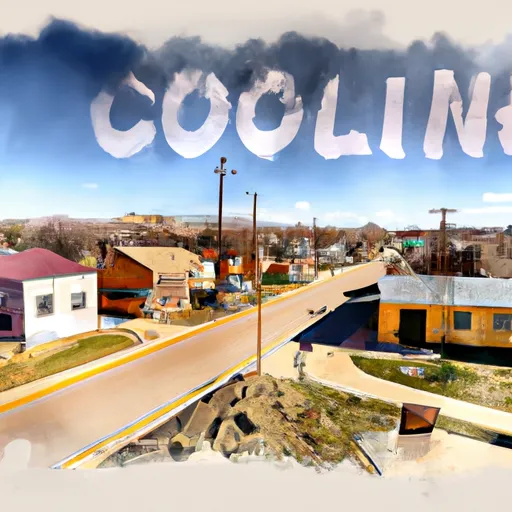-
 Snoflo Premium
Snoflo Premium
Get unlimited access to all our content
With no Ad interruptions! - Start Your Free Trial Login with existing account
Molina
Eden Index
Climate
8.4
•
Recreation
8.2
•
Community
•
Safeguard
6.2/10

Molina, Colorado is a small town located in Mesa County. It experiences a semi-arid climate with hot summers and cold winters. Summers are typically dry, with average temperatures ranging from the 80s to low 90s (Fahrenheit). Winters are cold, with temperatures dropping below freezing. Precipitation is generally low throughout the year, with most rainfall occurring during the spring and summer months.
Hydrology constituents in Molina are primarily influenced by the nearby Colorado River, which provides water for irrigation and recreational activities. The river plays a vital role in supporting agriculture in the region. Additionally, Molina is surrounded by beautiful natural landscapes, including the Grand Mesa National Forest and the Colorado National Monument. These areas offer numerous outdoor recreation opportunities such as hiking, fishing, camping, and wildlife viewing. The rugged terrain and stunning scenery make Molina an ideal destination for nature lovers and outdoor enthusiasts. Whether exploring the canyons, enjoying water activities on the river, or admiring the diverse plant and animal life, Molina offers a range of outdoor experiences for visitors and residents alike.
What is the Eden Index?
The Snoflo Eden Index serves as a comprehensive rating system for regions, evaluating their desirability through a holistic assessment of climate health, outdoor recreation opportunities, and natural disaster risk, acknowledging the profound impact of these factors on livability and well-being.
Climate Health Indicator (CHI): 8.4
Molina receives approximately
507mm of rain per year,
with humidity levels near 56%
and air temperatures averaging around
8°C.
Molina has a plant hardyness factor of
6, meaning
plants and agriculture in this region thrive during a short period during spring and early summer. Most
plants will die off during the colder winter months.
By considering the ideal temperature range, reliable water supplies, clean air, and stable seasonal rain or snowpacks, the Climate Health Indicator (CHI) underscores the significance of a healthy climate as the foundation for quality living.
A healthy climate is paramount for ensuring a high quality of life and livability in a region, fostering both physical well-being and environmental harmony. This can be characterized by ideal temperatures, reliable access to water supplies, clean air, and consistent seasonal rain or snowpacks.
Weather Forecast
Streamflow Conditions
Colorado Headwaters
Area Rivers
Colorado Headwaters
Snowpack Depths
Colorado Headwaters
Reservoir Storage Capacity
Colorado Headwaters
Groundwater Levels
Recreational Opportunity Index (ROI): 8.2
The Recreational Opportunity Index (ROI) recognizes the value of outdoor recreational options, such as parks, hiking trails, camping sites, and fishing spots, while acknowledging that climate plays a pivotal role in ensuring the comfort and consistency of these experiences.
Access to outdoor recreational opportunities, encompassing activities such as parks, hiking, camping, and fishing, is crucial for overall well-being, and the climate plays a pivotal role in enabling and enhancing these experiences, ensuring that individuals can engage in nature-based activities comfortably and consistently.
Camping Areas
| Campground | Campsites | Reservations | Toilets | Showers | Elevation |
|---|---|---|---|---|---|
| Jumbo | 26 | 9,791 ft | |||
| Spruce Grove - Mesa | 16 | 9,961 ft | |||
| Carp Lake | 20 | 10,267 ft | |||
| Ward Lake | 27 | 10,222 ft | |||
| Bonham Lake City Park | None | 9,861 ft | |||
| Eggleston | 6 | 10,170 ft | |||
| Kiser Creek | 12 | 10,112 ft | |||
| Collbran - Cottonwood Lake | 56 | 9,946 ft | |||
| Twin Lake | 13 | 10,395 ft | |||
| Weir and Johnson | 12 | 10,483 ft |
Nearby Ski Areas
Catastrophe Safeguard Index (CSI):
The Catastrophe Safeguard Index (CSI) recognizes that natural disaster risk, encompassing floods, fires, hurricanes, and tornadoes, can drastically affect safety and the overall appeal of an area.
The level of natural disaster risk in a region significantly affects safety and the overall livability, with climate change amplifying these risks by potentially increasing the frequency and intensity of events like floods, fires, hurricanes, and tornadoes, thereby posing substantial challenges to community resilience and well-being.
Community Resilience Indicator (CRI):
The Community Resilience Indicator (CRI) recognizes that education, healthcare, and socioeconomics are crucial to the well-being of a region. The CRI acknowledges the profound impact of these elements on residents' overall quality of life. By evaluating educational resources, healthcare accessibility, and economic inclusivity, the index captures the essential aspects that contribute to a thriving community, fostering resident satisfaction, equity, and social cohesion.

